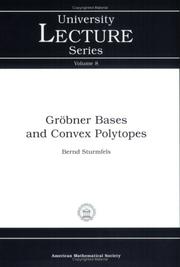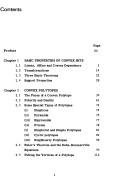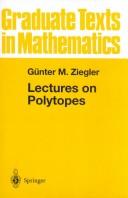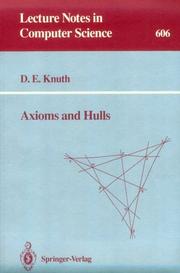| Listing 1 - 8 of 8 |
Sort by
|
Book
Year: 1967 Publisher: London Interscience
Abstract | Keywords | Export | Availability | Bookmark
 Loading...
Loading...Choose an application
- Reference Manager
- EndNote
- RefWorks (Direct export to RefWorks)
Book
ISBN: 1875399046 Year: 1992 Publisher: Glebe Carslaw Publications
Abstract | Keywords | Export | Availability | Bookmark
 Loading...
Loading...Choose an application
- Reference Manager
- EndNote
- RefWorks (Direct export to RefWorks)

ISBN: 0821804871 9780821804872 Year: 1996 Volume: 8 Publisher: Providence (R.I.) : American mathematical society,
Abstract | Keywords | Export | Availability | Bookmark
 Loading...
Loading...Choose an application
- Reference Manager
- EndNote
- RefWorks (Direct export to RefWorks)
Ordered algebraic structures --- Gröbner bases --- Convex polytopes --- 512.62 --- Grobner bases --- Polytopes --- Gröbner basis theory --- Commutative algebra --- Fields. Polynomials --- Convex polytopes. --- Gröbner bases. --- 512.62 Fields. Polynomials --- Gröbner bases

ISBN: 0521080177 9780521080170 Year: 1971 Volume: 3 Publisher: London: Cambridge university press,
Abstract | Keywords | Export | Availability | Bookmark
 Loading...
Loading...Choose an application
- Reference Manager
- EndNote
- RefWorks (Direct export to RefWorks)
Geometry --- Convex polytopes --- Polytopes convexes --- 514.17 --- Polytopes --- Convex sets. Geometric figure arrangements. Geometric inequalities --- Convex polytopes. --- 514.17 Convex sets. Geometric figure arrangements. Geometric inequalities --- Convex geometry --- Polyhedra --- Géométrie convexe --- Polyèdres --- Géométrie --- Géométrie convexe --- Polyèdres --- Géométrie
Book
ISBN: 052125597X 9780521255974 Year: 1984 Publisher: Cambridge: Cambridge university press,
Abstract | Keywords | Export | Availability | Bookmark
 Loading...
Loading...Choose an application
- Reference Manager
- EndNote
- RefWorks (Direct export to RefWorks)
Polytopes --- Combinatorial optimization --- Polyhedra --- #TELE:SISTA --- Hyperspace --- Topology --- Polyhedral figures --- Polyhedrons --- Geometry, Solid --- Shapes --- Optimization, Combinatorial --- Combinatorial analysis --- Mathematical optimization --- Geometry --- Convex polytopes --- Géométrie --- Polytopes convexes --- Géométrie

ISBN: 354094365X 038794365X 0387943293 3540943293 1461384311 9780387943657 Year: 1995 Volume: 152 Publisher: New York (N.Y.): Springer,
Abstract | Keywords | Export | Availability | Bookmark
 Loading...
Loading...Choose an application
- Reference Manager
- EndNote
- RefWorks (Direct export to RefWorks)
Discrete mathematics --- Probability theory --- Polytopes --- Polytopes. --- 514.17 --- 514.17 Convex sets. Geometric figure arrangements. Geometric inequalities --- Convex sets. Geometric figure arrangements. Geometric inequalities --- Hyperspace --- Topology --- Geometry --- Convex polytopes --- Géométrie --- Polytopes convexes --- Convex geometry --- Polyhedra --- Géométrie convexe --- Polyèdres --- Géometrie combinatoire

ISBN: 3540556117 0387556117 3540472592 Year: 1992 Volume: 606 Publisher: Berlin New York Springer-Verlag
Abstract | Keywords | Export | Availability | Bookmark
 Loading...
Loading...Choose an application
- Reference Manager
- EndNote
- RefWorks (Direct export to RefWorks)
One way to advance the science of computational geometry is to make a comprehensive study of fundamental operations that are used in many different algorithms. This monograph attempts such an investigation in the case of two basic predicates: the counterclockwise relation pqr, which states that the circle through points (p, q, r) is traversed counterclockwise when we encounter the points in cyclic order p, q, r, p,...; and the incircle relation pqrs, which states that s lies inside that circle if pqr is true, or outside that circle if pqr is false. The author, Donald Knuth, is one of the greatest computer scientists of our time. A few years ago, he and some of his students were looking at amap that pinpointed the locations of about 100 cities. They asked, "Which ofthese cities are neighbors of each other?" They knew intuitively that some pairs of cities were neighbors and some were not; they wanted to find a formal mathematical characterization that would match their intuition.This monograph is the result.
Algorithmes --- Algorithms --- Algoritmen --- Convex polytopes --- Convexe polytopen --- Matroiden --- Matroides --- Matroids --- Polytopes convexes --- Matroïdes --- 519.1 --- Combinatorial designs and configurations --- Polytopes --- Algorism --- Algebra --- Arithmetic --- Combinatorics. Graph theory --- Foundations --- Algorithms. --- Convex polytopes. --- Matroids. --- 519.1 Combinatorics. Graph theory --- Matroïdes --- Information theory. --- Computer science. --- Computer graphics. --- Computer software. --- Combinatorics. --- Theory of Computation. --- Computer Applications. --- Discrete Mathematics. --- Computer Graphics. --- Algorithm Analysis and Problem Complexity. --- Combinatorics --- Mathematical analysis --- Software, Computer --- Computer systems --- Automatic drafting --- Graphic data processing --- Graphics, Computer --- Computer art --- Graphic arts --- Electronic data processing --- Engineering graphics --- Image processing --- Informatics --- Science --- Communication theory --- Communication --- Cybernetics --- Digital techniques
Book
Year: 2019 Publisher: MDPI - Multidisciplinary Digital Publishing Institute
Abstract | Keywords | Export | Availability | Bookmark
 Loading...
Loading...Choose an application
- Reference Manager
- EndNote
- RefWorks (Direct export to RefWorks)
This book contains the successful invited submissions to a Special Issue of Symmetry on the subject of ""Graph Theory"". Although symmetry has always played an important role in Graph Theory, in recent years, this role has increased significantly in several branches of this field, including but not limited to Gromov hyperbolic graphs, the metric dimension of graphs, domination theory, and topological indices. This Special Issue includes contributions addressing new results on these topics, both from a theoretical and an applied point of view.
Zagreb indices --- domination --- Devaney chaos --- rotationally-symmetric convex polytopes --- topologically mixing --- geometric arithmetic index --- connectivity --- Metric dimension --- atom-bond connectivity ABC index --- distinguishing number --- gear graph --- titanium difluoride --- algorithm --- generalized gear graph --- general Randi? index --- cuprite --- atom bond connectivity index --- binary locating-domination number --- basis --- hypercyclicity --- functigraph --- complete graph --- alpha-boron nanotube --- general randi? index --- geodesics --- inverse degree index --- Hex-Derived Cage networks --- metric dimension --- dominating set --- bipartite graphs --- products of graphs --- geometric-arithmetic GA index --- direct product of graphs --- gromov hyperbolicity --- secure resolving set and secure resolving domination --- topological indices --- graph operators --- resolving set --- harmonic index --- polycyclic aromatic hydrocarbons --- ILP models --- disjointness --- topological transitivity --- Gromov hyperbolicity --- metric basis --- harmonic polynomial
| Listing 1 - 8 of 8 |
Sort by
|

 Search
Search Feedback
Feedback About UniCat
About UniCat  Help
Help News
News